Physical Address
304 North Cardinal St.
Dorchester Center, MA 02124
Physical Address
304 North Cardinal St.
Dorchester Center, MA 02124
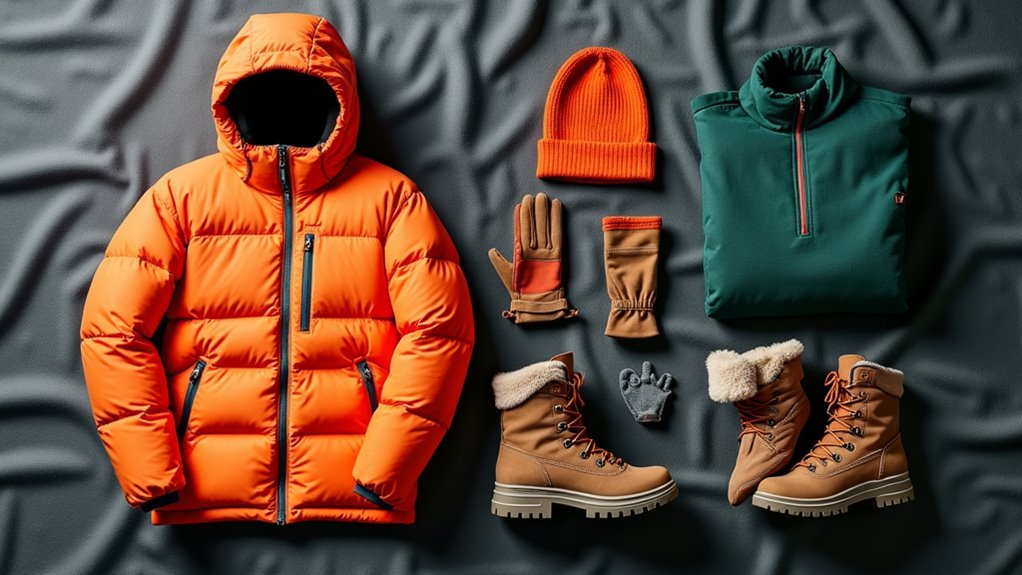
Outdoor adventures demand proper layering systems that separate novice campers from seasoned survivors—discover which fabrics keep you alive.
When Mother Nature decides to test your resolve with her winter moods, you’ll quickly discover that cotton kills and cheap gear costs more in the long run. You don’t need to break the bank, but you can’t afford to cut corners on the essentials either. The three-layer system isn’t just outdoor industry jargon—it’s your lifeline between comfort and hypothermia. Master this foundation, and you’ll understand why experienced hikers swear by specific fabric choices that could save your next winter adventure.

When temperatures drop and wind starts biting through your jacket, you’ll quickly realize that throwing on a thick coat isn’t enough to stay warm outdoors. The three-layer system gives you flexible temperature control without breaking your budget.
Your base layer wicks moisture away from skin—synthetic materials or merino wool work best, while cotton kills.
The insulating middle layer traps warm air using fleece, down, or synthetic fill. Choose based on your budget and whether you’ll encounter wet conditions.
Your outer shell blocks wind and precipitation. You don’t need expensive gear initially—a basic windbreaker beats nothing.
This system lets you add or remove layers as conditions change, keeping you comfortable whether you’re hiking uphill or sitting around camp. Proper layering techniques are essential for maintaining optimal body temperature during cold weather hiking adventures.
Since your base layer sits directly against your skin, it’s the most critical piece of your cold-weather system—and fortunately, it doesn’t have to cost a fortune.
Your base layer’s job is moving sweat away from your body, not keeping you warm.
Look for synthetic materials like polyester or natural merino wool. Both wick moisture effectively, though merino costs more and resists odors better.
Skip cotton entirely—it holds moisture and loses insulation when wet.
Proper base layer selection is fundamental to safe outdoor camping practices, as hypothermia remains one of the leading risks in cold-weather environments.
Key features to prioritize:
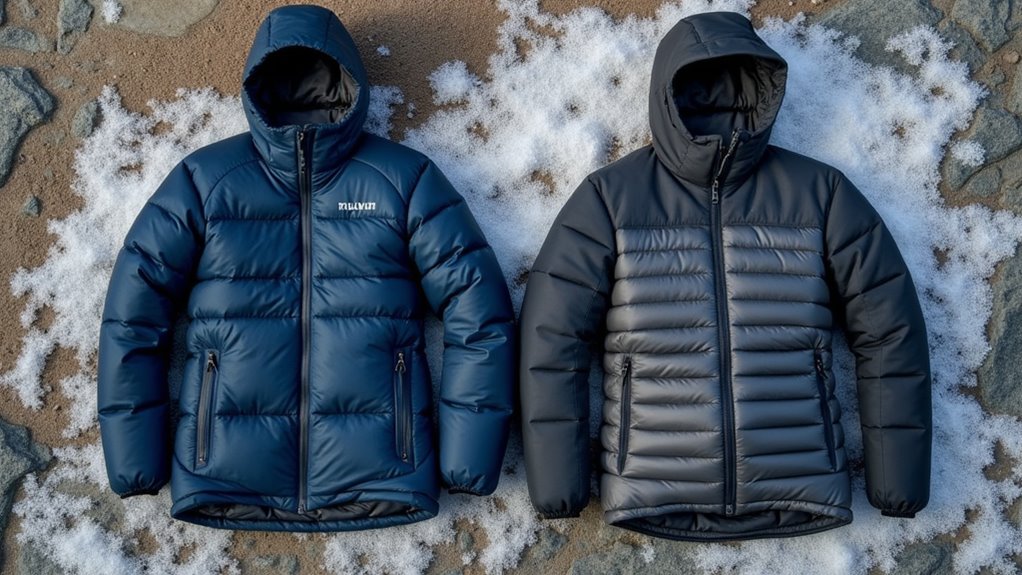
While your base layer moves moisture away from your skin, your mid-layer’s primary job is trapping warm air to keep you comfortable when temperatures drop.
You’ll face two main insulation choices: down and synthetic fill.
Down offers superior warmth-to-weight ratio and compresses smaller in your pack. However, it’s pricier and loses insulating power when wet. Duck down costs less than goose down while still providing excellent warmth.
Synthetic fill costs notably less and retains warmth even when damp. It’s also easier to care for and dries faster. The trade-off? It’s bulkier and heavier than down.
For budget-conscious hikers in wet climates, synthetic makes sense. If you’re tackling dry, cold conditions and don’t mind spending more, down’s efficiency is hard to beat.
If you’re planning to explore camping destinations by motorhome, Britain’s Motorhome Show offers excellent opportunities to discover gear recommendations and connect with fellow outdoor enthusiasts.
Your outer shell acts as the final barrier between you and harsh weather, making material choice essential for staying dry and comfortable. You’ll encounter two main waterproof technologies: membrane-based fabrics like Gore-Tex and DWR-coated materials.
Membrane fabrics offer superior long-term waterproofing but cost considerably more. DWR coatings provide decent protection at budget-friendly prices, though they’ll need retreatment over time.
Consider these key factors when selecting your shell:
Don’t overlook used gear markets for premium shells at reasonable prices. High-altitude environments like the Andes mountains present unique challenges that demand reliable waterproof protection for serious adventurers.
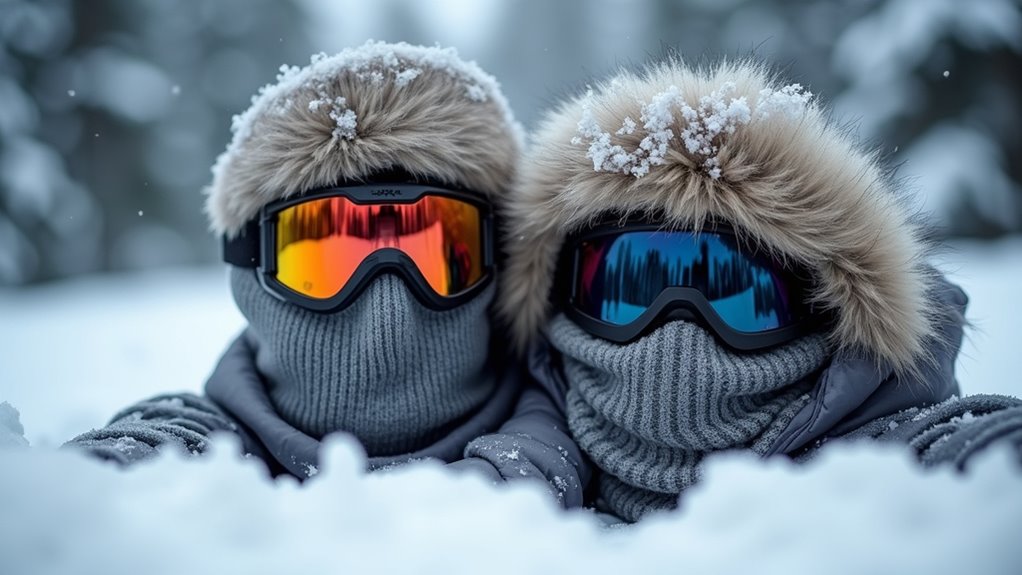
When temperatures plummet and wind picks up, exposed skin on your head and neck loses heat faster than any other part of your body. You’ll need a warm hat that covers your ears—wool or synthetic fleece work best and won’t lose insulation when wet.
Your head and neck lose heat faster than anywhere else when temperatures drop and wind intensifies.
A neck gaiter or balaclava seals the gap between your jacket collar and hat, preventing heat loss through your neck’s major blood vessels.
For face protection, consider a lightweight face mask or bandana that you can pull up when wind chill becomes dangerous. Choose moisture-wicking materials that won’t freeze from your breath.
Pack a backup hat since they’re easily lost in windy conditions. These lightweight items cost little but make the difference between comfort and potential frostbite.
Just like deciding whether to rent or buy equipment for any outdoor activity, weigh the costs and frequency of your cold-weather adventures when investing in quality head protection gear.
Because your extremities receive less blood flow in cold conditions, your hands and feet become vulnerable to frostbite within minutes of exposure. You’ll need layered protection that keeps moisture away while maintaining dexterity and warmth.
For hands, start with thin liner gloves under insulated mittens or gloves. Mittens keep fingers warmer since they share heat, but gloves offer better grip for hiking poles and gear.
Your feet require moisture-wicking liner socks under wool or synthetic hiking socks. Never wear cotton socks in cold weather—they’ll hold moisture and freeze.
Essential hand and foot warmth strategies:
If you’re planning to sleep outdoors in cold jungle environments, consider that a hammock setup can help keep your feet elevated and away from cold, wet ground conditions.
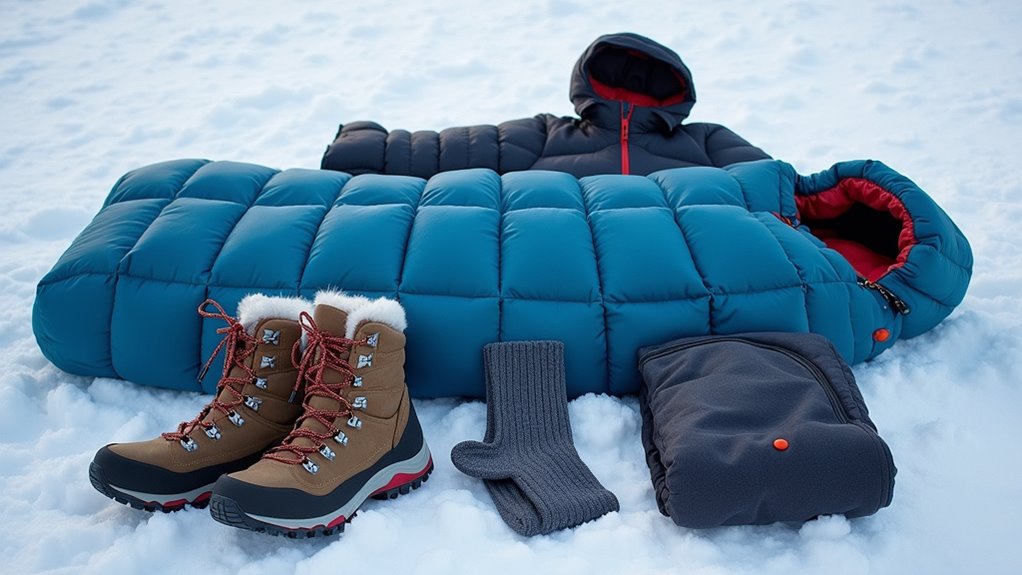
Beyond protecting your hands and feet, different winter activities demand specific clothing adjustments that match their unique demands.
For snowshoeing, you’ll generate more heat than regular hiking, so wear fewer layers and choose breathable fabrics to prevent overheating.
Cross-country skiing requires flexible clothing that won’t restrict arm movement—avoid bulky jackets and opt for stretchy mid-layers.
Winter camping needs extra insulation since you’ll move less around camp. Pack a puffy down jacket that compresses well but provides serious warmth during rest periods.
Ice fishing or stationary activities require maximum insulation since you’re barely moving.
For alpine activities, prioritize wind protection and moisture management. Shell layers become crucial when weather changes quickly.
Always pack backup layers regardless of your activity—conditions can shift fast in winter mountains.
If extreme winter conditions prove too challenging for tent camping, consider RV camping as an alternative that still lets you enjoy outdoor adventures with better climate control.
Although marketing claims can make fabric choices seem overwhelming, understanding three core material categories will help you make smart decisions without breaking the bank.
Skip the marketing hype and focus on three essential fabric types to make budget-friendly gear decisions.
Merino wool excels at temperature regulation and odor resistance, making it perfect for multi-day trips. It’s naturally antimicrobial and stays warm when wet, though it costs more upfront.
Synthetic blends offer excellent value and durability. They dry quickly, retain insulation when damp, and won’t break your budget. Look for polyester or nylon blends for base layers.
Technical materials like softshells and hardshells provide specialized protection:
Focus on versatile pieces that work across multiple conditions rather than sport-specific gear. Proper clothing selection becomes even more critical when family camping adventures extend into colder months or challenging weather conditions.
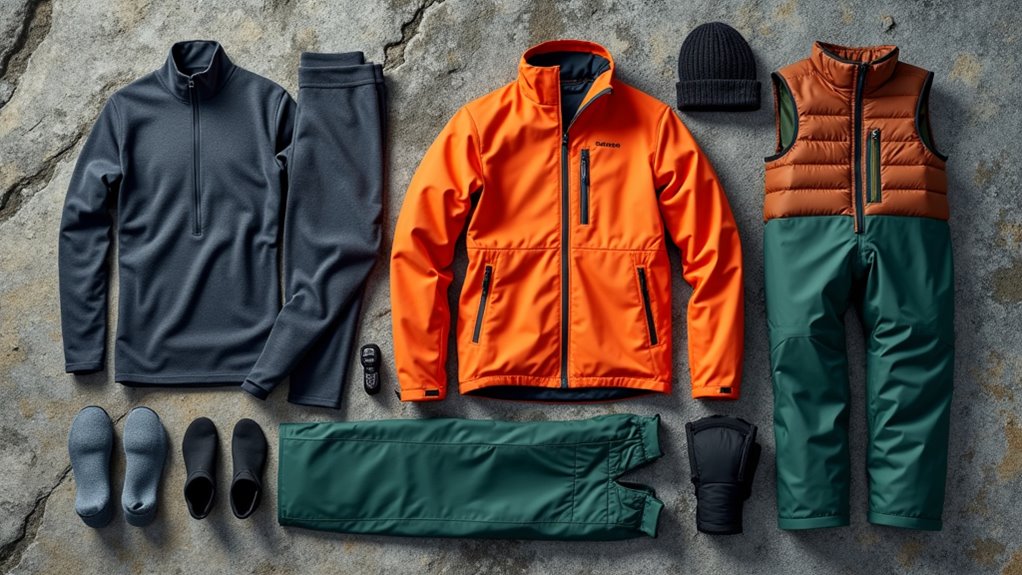
Smart fabric choices mean nothing if you can’t adapt to changing conditions on the trail. You’ll need a flexible layering system that works with your budget and activity level.
Start with a moisture-wicking base layer—synthetic or merino wool both work well. Add an insulating mid-layer like fleece or down that you can easily remove when you’re working hard.
Your outer shell should breathe while blocking wind and rain.
The key is staying ahead of temperature swings. Remove layers before you overheat, and add them back before you get cold. This prevents the sweat-freeze cycle that kills warmth retention.
Don’t overcomplicate it—three quality layers beat five mediocre ones. Focus on versatile pieces that serve multiple purposes and pack small. Remember that proper winter camping attire requires special attention to extremities like hands and feet, which lose heat rapidly in cold conditions.
When you’ve invested in quality cold-weather gear, proper care extends its life and saves you money in the long run. Your expensive jackets and base layers deserve attention to maintain their performance and durability.
Follow these essential maintenance practices:
Regular inspection for wear spots, loose seams, and zipper issues prevents small problems from becoming expensive replacements. Well-maintained gear becomes especially critical for extreme conditions like glacier climbing, where equipment failure can pose serious safety risks.
You’re now armed with the knowledge to tackle winter’s bite head-on. Remember, you don’t need to break the bank—start with quality base layers and build your system over time. Take care of your gear, and it’ll take care of you for years to come. Most importantly, listen to your body and adjust your layers as conditions change. With smart layering choices, you’ll stay warm, dry, and ready for whatever Mother Nature throws your way.